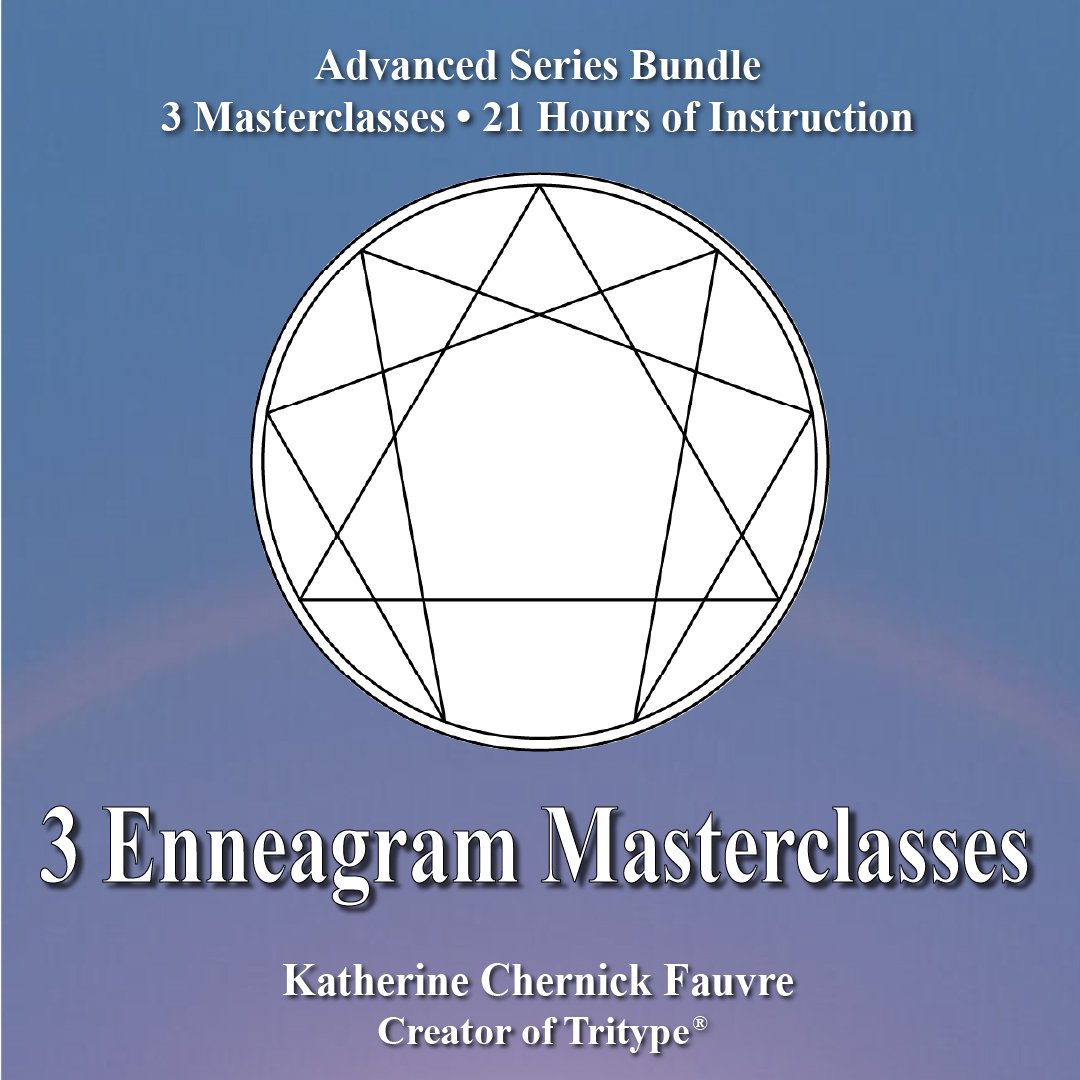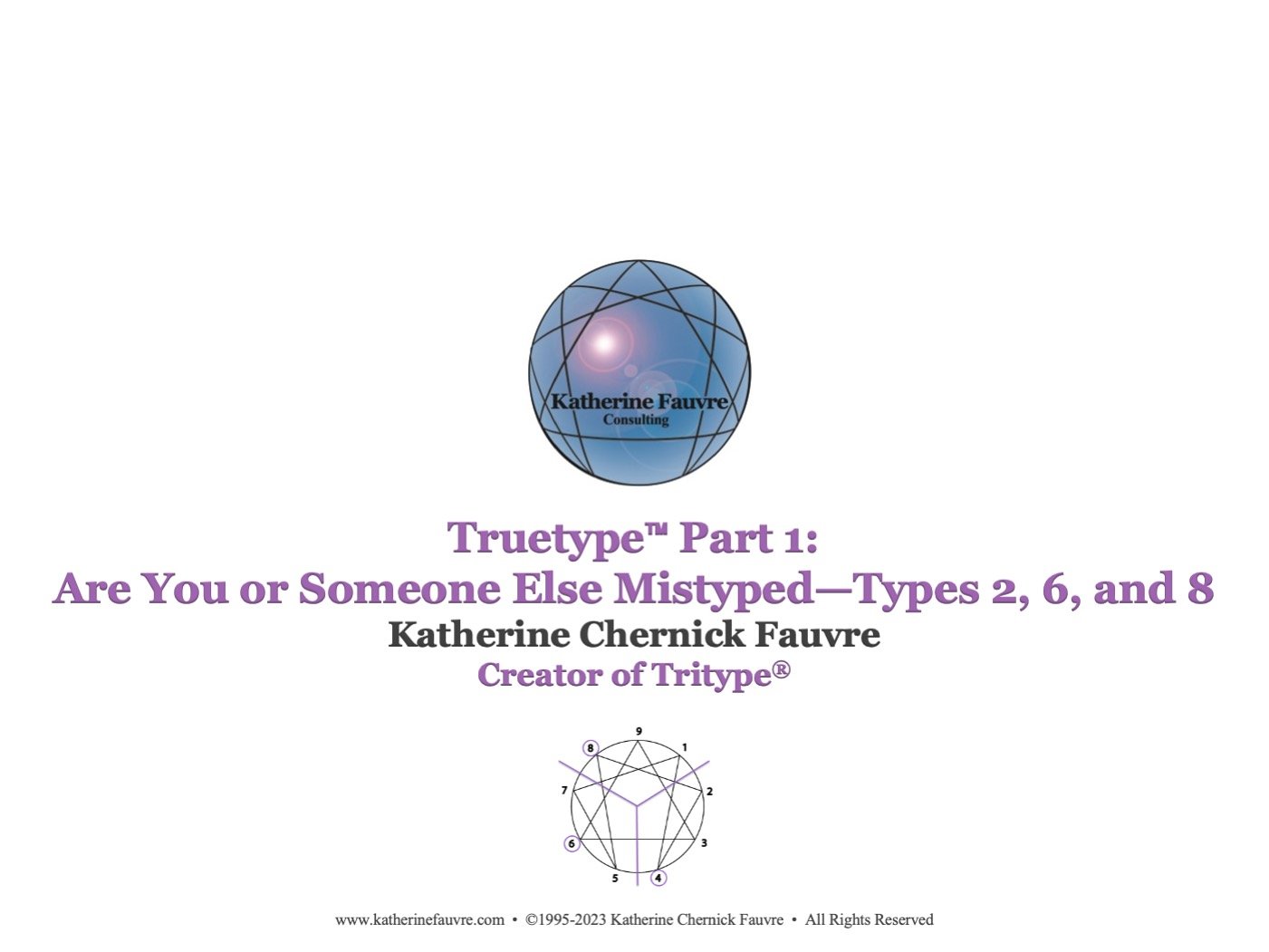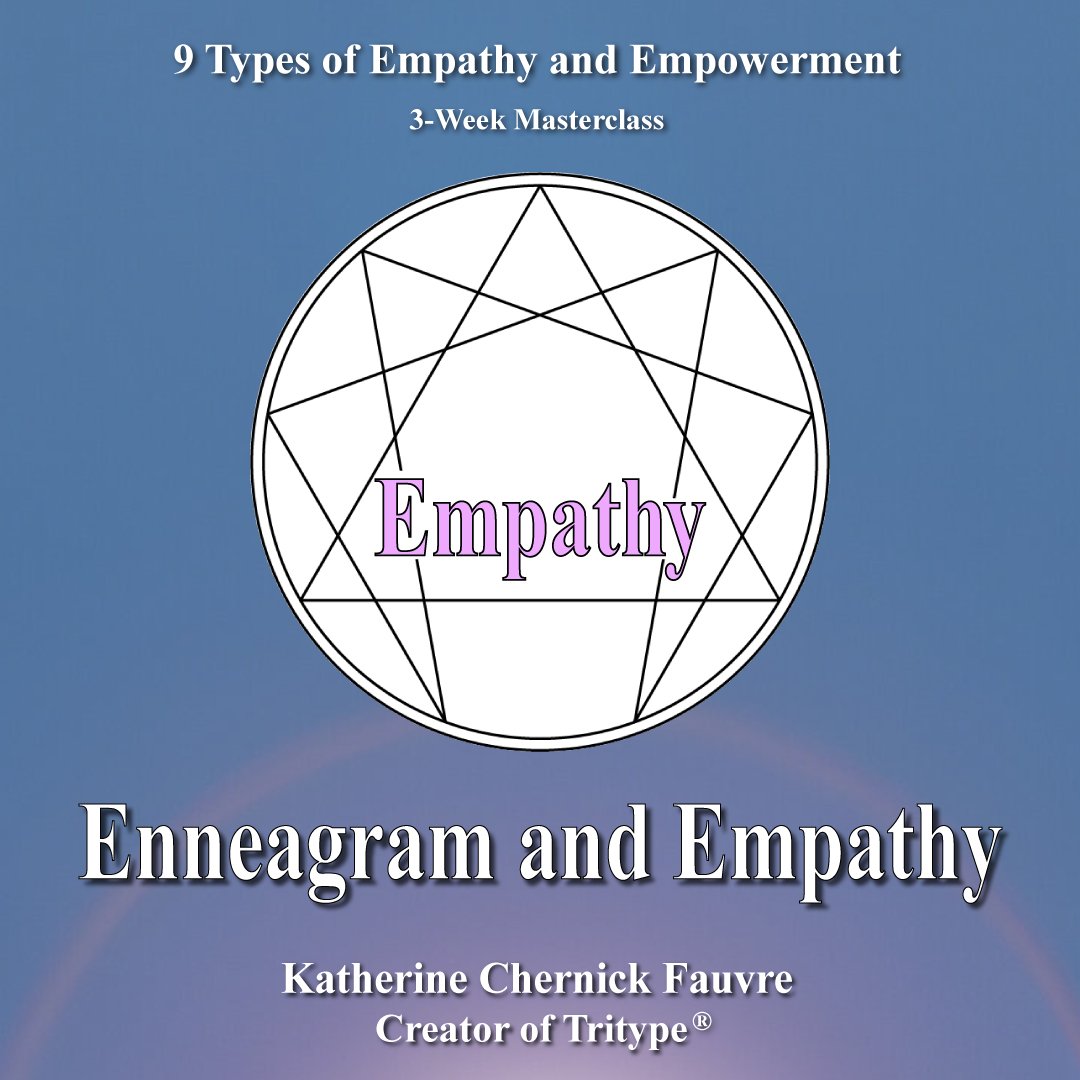Advanced Series Bundle: Speciality Trio • 3 Masterclasses in 1 • Discover what you may not know about the Enneagram
Advanced Series Bundle: Speciality Trio • 3 Masterclasses in 1 • Discover what you may not know about the Enneagram
This bundle of three masterclasses is based on Katherine's extensive research and can not be found anywhere else. Included in the bundle are the following masterclasses:
• Enneagram of Process and Archetypal Roles
• Lost in Transmission: What was Unknown, Lost, or Misunderstood about the Types
• Enneagram Subtype Countertypes: Evolution of Countertypes and Instinctual Stackings
Read below for details on each masterclass.
About each masterclass in this bundle:
Enneagram of Process and Archetypal Roles 3-week Masterclass Advanced Series
Learn why the Types and Tritypes® feel they must focus on being a certain way in the world.
Therapists • Coaches • Guides • Mentors • Enthusiasts
This masterclass covers the continuous movement of the types through the Enneagram. You will learn the how and why the types move in the manner they do, that it is not random, and why there is a specific order to the Enneagram and what that order reveals about your type.
What is the Enneagram of Process? Why is it important?
The Enneagram of Process: Initiation to Actualization is a comprehensive framework that draws upon the wisdom of the Enneagram to guide individuals and organizations through a transformative journey. This 9-point process aligns with the nine distinct personality types of the Enneagram, combining their unique attributes to facilitate the path from initiation to actualization. Each step encapsulates a set of principles and actions driven by the characteristics of the corresponding Enneagram type. Together, they form a holistic approach to achieving goals, fostering growth, and embracing personal development.
The Enneagram of Process 9-Point System provides a structured roadmap for personal and professional evolution. Together, the nine steps encompass the Enneagram's wisdom, guiding individuals and organizations from inception to actualization, recognizing the whole is greater than the sum of its parts. These processes are based on your Tritype®. The ones that we primarily use are included in our Tritype®.
What are the Enneagram Archetypal Roles and why are they essential to understanding the focus of each Type?
The Enneagram offers valuable insights into the distinct roles that individuals of each Enneagram type frequently undertake in diverse systems, whether it’s within families, relationships, or workplaces. These roles play a vital function in facilitating a sense of belonging and security, often representing archetypal patterns that align with the core motivations of each Enneagram type.
One intriguing aspect of the Enneagram system is the use of a three-role hierarchy based on one’s personal Tritype® Stacking Order. This unique configuration allows individuals to identify their primary, secondary, and tertiary roles within various contexts, offering a deeper understanding of how they interact with others and navigate the challenges of life. By recognizing and exploring these roles, individuals can gain valuable insights into their behavior, motivations, and relationships, ultimately helping them to navigate the complexities of the human experience with greater self-awareness and clarity.
Lost in Transmission: Discover What was Unknown, Lost, or Misunderstood About the Types - 3-Week Masterclass
Expand your understanding of the Enneagram Types...
• Clear up common mistypings.
• Learn what you didn’t initially learn about types.
• Discover what was inadvertently lost…
• Unknown, or misunderstood in the transmissions of the Enneagram.
Learn more about The 4 Transmissions of the Enneagram:
• Discover what was lost along the way.
• Have you ever wondered why types 2, 6, and 9 have such narrow personality styles?
• Learn about the confusion between types 2 and 7, types 6 and 4, types 1 and 5.
• How the sp 3 can seem 8ish whereas the sx 3s can seem 7ish, and how that came about.
• Or why the social 2 is mistyped as a 3...
• Learn why some types have fewer archetypes; what went missing, and why...
• Expand your knowledge of the types.
• Learn what you didn't know that was lost in transmission
Have you noticed gaps in the teachings of the Enneagram? Types that seem less diverse than others with fewer Archetypes? Well, you are right! As with any transmission of material, aspects can be unknown, lost or misunderstood and thus vary from other teachings.
• Why is the magical sx3 taught as a sx7?
• What happened to the Wild Child type sx2?
• Why does the sx5 long for love they do not feel worthy of?
• Why is the intellectual 9 taught as a type 4 without envy?
• Why is the sensitive and creative sx 6 taught as a type sx3?
The Enneagram of Personality, as we know it today, began in Arica, Chile, in 1970. It has grown and expanded in many diverse ways.
Due to Katherine attending intensives with Ichazo, Naranjo, Riso, Hudson, Palmer, Daniels, Hurley, Dobson, and others, she could see what was lost in the transmissions of the Enneagram. She saw key archetypes of the Types critical to accurately understanding the Types. Losing information in the transmission of the Enneagram has unfortunately led to some mistypings.
What are the key distinctions and archetypes of the types that were unknowingly or inadvertently lost along the way?
Oscar Ichazo’s Enneagram of Personality, as we know it today, originated in Arica, Chile, between 1968 and 1970. It was first taught on July 1, 1970, and has evolved and expanded in various ways.
As an avid student and teacher of personality typologies, Katherine studied with everyone, including attending intensives with Oscar Ichazo and Claudio Naranjo. She certified with Palmer-Daniels, Riso-Hudson, and Hurley-Dobson, and attended workshops with Condon, Jackson-Bear, and Wolinsky. She has also conducted 24 qualitative research studies on the “internal experience” of the Enneagram Types, Tritypes®, and Instincts, interviewing over a hundred thousand participants, expanding her understanding of the Enneagram types and contributing to a diverse and holistic view of the types.
Discover what was inadvertently lost, Unknown, or misunderstood in the transmissions of the Enneagram.
With each Enneagram workshop, intensive, and certification program, Katherine learned more and more exciting details about the inner world and inherent nature of the types and how each Enneagram Type wants to be nurtured and understood at a fundamental level.
The distinct contributions made by the Enneagram teachers have shaped our view of the types. Each transmission added key nuances to the Enneagram, with the whole of the Enneagram being far greater than the sum of its parts.
In this 3-week video recording, Katherine shares simple facts about the history and evolution of the Enneagram Types, Subtypes, Stackings, and Tritypes® that will enhance your definitions of the types and pave the way to seeing new dimensions within types.
Understanding and restoring the details and explanations missed in the transmissions of the Enneagram types can clear up simple misunderstandings and misattributions as well as enhance what you already know. Learning what was lost and found along the way keeps the study of types alive and exciting, adding new dimensions that were inadvertently lost between transmissions.
Restoring aspects of the types are easy to integrate because they make sense.
Evolution of Enneagram Countertypes and Instinctual Stackings 3-Week Masterclass: Advanced Series
• What you didn't know about the evolution of Subtype Countertypes
• How to use your Instinctual stacking order
• The dilemma if you have a Countertype as your second Instinct
• Find out if you have a Countertype or a secondary Countertype
• Delve deeply into your type and Tritype® using Countertypes
• Unfamiliar with Countertypes?
• Find more in The Definitive Enneagram (coming in 2023)
The term “Countertype” was first used by Claudio Naranjo in 1971. He coined the term to explain the characteristics of the strong reaction of the counterphobic 6 that manages fear by immediately moving into the fear instead of avoiding it.
In 1994, Katherine began her formal research studies on the "internal experience" of Enneagram types and subtypes. During her research, she noticed that each Enneagram type seemed to have a "stereotype" and two "countertypes."
The “stereotype” occurred when the core fear of the Enneagram type matched the core fear of the instinctual type accentuating the focus of attention. The two “countertypes: within a type occurred when the core fears of the Enneagram type’s center combined with the core fears of the other two instinctual types.
It is important to note that in 1971, Claudio Naranjo began recognizing a more primitive expression of Ichazo’s ego types. It was at this time, that he added his theory of Subtypes. He placed the primal aspects of Ichazo’s three Instinctual Triads (centers) under each Enneagram type as the three subtypes of Ichazo’s ego types.
Extensive study confirms that there are three instinctual drives or types -the Self-Preserving, the Social, and the Sexual/Intimate. Like the nine passions of the Enneagram points, the instinctual drives act as a force underlying our life strategies - often unconscious yet all-pervasive - and represent our most fundamental way of being. The three instinctual drives color how we act, think, feel, and ultimately express ourselves. Each instinctual drive manifests within each of the nine Enneagram types (in effect resulting in a total of 27 Instinctual Subtypes).
Ichazo taught that "the instincts are defined . . . as three fundamental reactions of our organism in order to sustain life. The interconnection between them produces a corresponding triad in the higher psychological levels, and the sensing of these three organic systems appear as our basic psychological levels in the form of instinctual centers of attention, whose demands we cannot ignore because they immediately threaten our survival."
Naranjo taught his subtypes to Ichazo’s ego types are the primitive still that " the instinctual type is one of three sub-personalities that is the "auxiliary passion." He suggests that outwardly the instinctual subtype can look positive, like a talent, or something of which one should be overly proud, but inwardly is a reflection of unhappiness with a price to be paid -, e.g., "the oyster is not too interested in the price of the pearls." He also teaches the origin and drive of each instinctual subtype: self-preservation arises in the belly and is associated with protection; social instinct arises in the tongue, and the desire to be appreciated; and sexual instinct is genital in origin and driven by sexuality, oedipal issues."
Katherine Chernick Fauvre, the creator of Tritype® and Instinctual Stackings, is an internationally recognized personality expert. She is an IEA Accredited Teacher with Distinction and is Triple Certified: Palmer-Daniels, Riso-Hudson, and Hurley-Dobson. She is also distinguished to be the only person in the world to have attended intensives with both Claudio Naranjo and Oscar Ichazo. In 1996, Naranjo validated her 1995 Research on the Instinctual Subtypes. Her 23 qualitative research studies on the Enneagram Types and her many innovative courses correlating the Enneagram with many other fields such as Karen Horney, MBTI, Archetypes, micro-expressions, talk styles, lexicon use, gestures, and body language have made her a master profiler and thought leader in the field.






